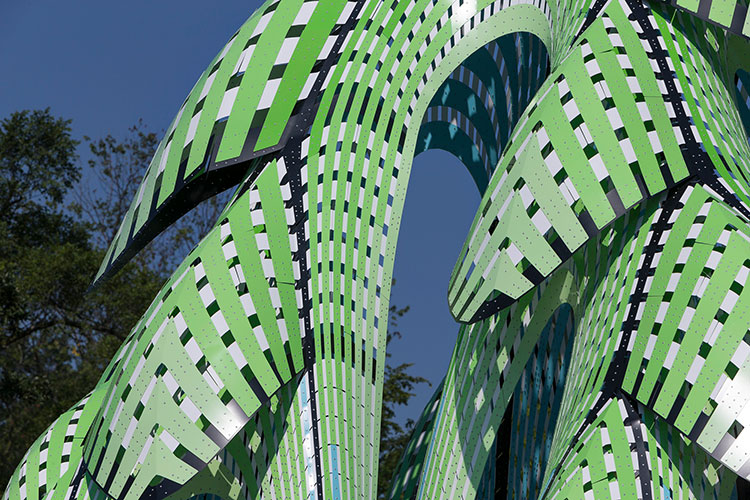On the road to Riverwood, a peak among pines announces the sprawling park, a scenery of natural splendor, but unreal experiences. Pine Sanctuary by Marc Fornes / THEVERYMANY is a “placemaker” for Riverwood Conservancy in Mississauga, Canada.
It signals the entrance to the park and provides a unique spatial experience for visitors to wander through and enjoy. From the speed of a car driving down Burnhamthorpe Road West, the piece stands out as a visual icon, but its tall and pointed profile is at home in the context of Riverwood’s pine trees, even if it provokes a second look.

But is it a tree? Real-world comparisons are subjective; depending on the person viewing, they may vary from flower to petals to spanning webs. The colors of the piece pop. They are borrowed from their environment, but heightened and pushed to the realm of pop artificiality: a stepped gradient of aqua, chartreuse, and cyan vibrates among other greens and blues. This first glimpse of Pine Sanctuary instills a childlike sense of curiosity. An inviting enclosure at a scale between sculpture and architecture, at once playful and mystical, it tempts a passerby to enter.

Inside, intrigue is rewarded with a unique experience of space and light, and a deep, quiet, contemplative appreciation. This might translate into wonder about what this fantastical anomaly is, and how it was made, or something more introspective and meditative. The delaminated, double-layered skin provides a moiré of colors, as well as shadows and speckled light to catch on the ground. This is a place for spontaneous play as much as it is a sanctuary for one to simply lose their time.

In a kind of dance, this system of branches rotates around a center point. The overall geometry is comprised of an aggregation of dripping “Macro Shingles” which form pockets of space, blurring the lines between inside out, while increasing shadowy coverage. There’s no trunk holding up this arboreal structure. Instead, it opens up into a shady space. Macro shingles resolve into branches that touch the ground lightly around a covered grove, like a redwood hollowed out. A top central moment peels away and branches into several feet that lightly meet the ground, along the way creating a labyrinth through which one can slip in, out and around. Circling the structure, no facade ever repeats itself. The new, unique angle upon every step forward prolongs the sense of discovery.

“Bending-Active” describes a form-finding process that derives from the elastic deformation of a plate element. In this case, the bending behavior of 2mm thick aluminum stripes assumes curvature to gain structural performance. Much of the existing research on bending-active structure investigates the elastic properties of wood; yet wood cannot fold or crease. Here, thin aluminum allows us to create a hybrid structure: most of the stripes bend into place while also connecting to a thin spine made from folded plates, articulated in black.

The project is an example of the studio’s innovative “Structural Stripes”—a building system in which a continuous surface is de/composed into custom designed and digitally fabricated parts, cut from ultra-thin aluminum. They laminate in multiple directions to create the curvilinear form of each component piece. Linear stripes and arching components are lasers cut from thin-gauge aluminum sheets and painted with fours shades of green, a blue, black and white to produce a dynamic coloration across the whole system.

The stripes of Pine Sanctuary adjust in density, so that gaps between them generate areas of porosity. In petal-like forms, the stripes merge together at the base, offering spaces where dancers and explorers and tree-dwellers of all kinds can tuck in, recline, or hide for a moment. 3,161 unique stripes accumulate to host these activities. Pine Sanctuary is the studio’s second public art project in Canada, after “Vaulted Willow,” a permanent folly in Borden Park in Edmonton, commissioned by the Edmonton Arts Council.







